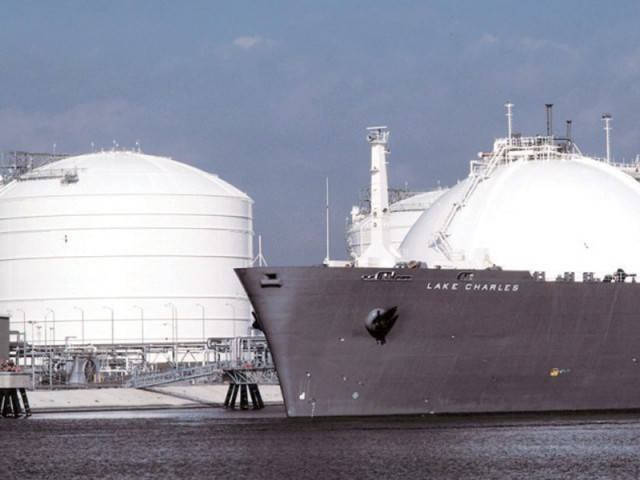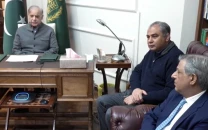The LNG mess: In the fight for imports, only the strongest will survive
Five groups are vying for profitable project of setting up terminal and collecting dollar-denominated rent from govt.

The project structure involves LNG processing plant and storage tanks mounted on a ship – the FSRU, which will be anchored along one of the existing or new berths. PHOTO: FILE
It is a game of survival of the fittest. In the bitter struggle to have a share in the business of importing gas to Pakistan, only the strongest will emerge victorious.
Islamabad has been trying to import liquefied natural gas (LNG) for seven years now. Officials say it is imperative. Forced disruption of supply to factories, fertiliser and power plants cannot go on especially as it tries to push up growth.
Around a dozen attempts to import LNG have met the same fate. They have simply fizzled out or ended up in court with one of the private groups feeding the media with stories of corruption committed by its rivals.
People have been confused for far too long with terms like integrated, unbundled and retrofit projects and even senior bureaucrats confide that they can barely understand the issues.
The latest attempt, which seeks to start import by early 2015, is already under the spotlight with dissenting views appearing in various newspapers.

In simple words, Pakistan needs gas. It is willing to pay the price. Its economy is in bad shape and foreign exchange reserves often dwindle. So it will give sovereign guarantees to the LNG supplier.
The companies vying for the project do not have to buy LNG. They do not even have to transport it. They only invest in a terminal, which receives LNG, converts it into gas before pumping it into the pipeline system.
This terminal operator will receive payments under the head of a tolling tariff in dollars or dollar equivalent rupees.
This is not all of it. Government has assured a capacity utilisation of 90%, which means the terminal operator will be paid for 90% of the capacity even if no LNG is received – this is a sort of a hedge against swift changes in official policies.
Five groups are vying for the latest LNG terminal - the so-called fast-track project, which wants first gas delivery in 11 months from the award of contract.
Engro Vopak, Fauji Group, Turkey’s Global Energy, Pakistan Gas Port Limited and Korea’s Daewoo Shipbuilding and Marine Engineering Company are all in the running. And they hate each other. October 1 is the last date for submission of bids.
“We will go ahead with it at any cost. A lot of damage has been done by making LNG imports controversial. Now we won’t be deterred by any pressure or threat of court cases,” said a senior petroleum ministry official, who is directly involved with the project.
“We have to set up the terminal first before we strike any deal with LNG suppliers,” he said, requesting anonymity. (Prime Minister Nawaz Sharif’s government received a cold shoulder from the Qataris who want Pakistan to build a terminal before coming to negotiate any deal on supplies.)
“The terminal will be located at Port Qasim. Interested parties are free to choose a place, do the calculations and come up with a tolling tariff, and the lowest bidder gets the project.”
He complained that successive attempts were bogged down by unnecessary litigation. “Lawyers write us ten-page letters. When will the petroleum ministry work if it continues to respond to legal letters?”
There is no denying that Pakistan needs gas. Demand has surged past six billion cubic feet (bcf) a day against production of 4.2bcf. When there is a crisis, there is an opportunity to make money. All the contestants know this.
While it has not been clearly stated, it is understood that the project structure involves a LNG processing plant and storage tanks mounted on a ship – the FSRU, which will be anchored along one of the existing or new berths. There is no way a terminal can be built onshore within the 11-month deadline!
Interviews with five officials representing different stakeholders, suggest project cost will range from $80 million to $250 million depending on the location and the nature of the project.
If the terminal tariff is calculated at conservative 80 US cents per million British thermal units (mmbtu) at the maximum 400mmcfd output, even then revenue comes to $115 million.
Even if the rent on barge-mounted terminal and other variable costs are accounted for, the net profit will be in the range of $55 million to $60 million a year.
“It’s as good as investing in an independent power producer (IPP),” said an expert who has advised the government on energy issues. “High internal rate of return, air tight agreement...it has everything to woo investors.”
But Sui Southern Gas Company Managing Director Zuhair Siddiqui believes the debate around terminal tariff makes little sense. “Does tolling tariff really matters when we desperately need gas. If we don’t do this now, there will be gas riots in Punjab.”
Total price of imported gas will be around $15-$16 per mmbtu, way higher than the domestic wellhead price of $4.
Siddiqui says it has yet to be decided how the difference between the two prices will be bridged. It is very likely, that LNG will be dedicated to the power plants, which currently consume even expensive furnace oil.
Published in The Express Tribune, September 18th, 2013.
Like Business on Facebook, follow @TribuneBiz on Twitter to stay informed and join in the conversation.



















COMMENTS
Comments are moderated and generally will be posted if they are on-topic and not abusive.
For more information, please see our Comments FAQ